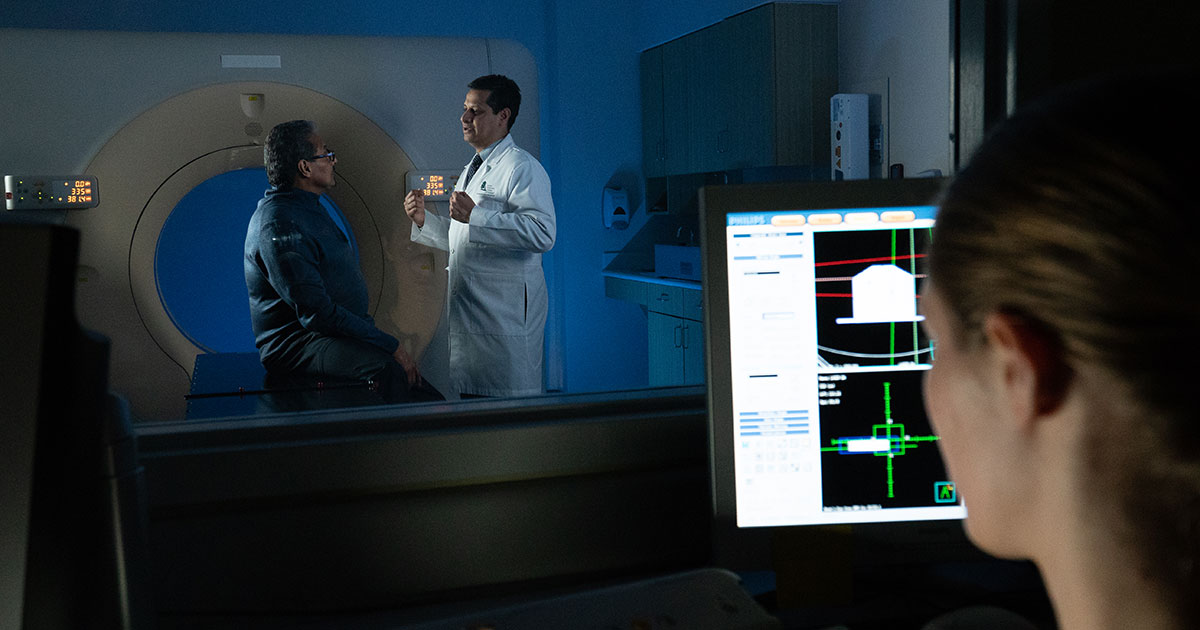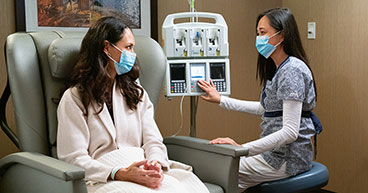
Radiation is a form of energy you can’t see, hear, feel, smell or taste. Harnessing its power to kill cancer cells is widely recognized as one of the major advances of the 20th century. But soon after scientists started using radiation to treat cancer, they discovered it could also contribute to its cause and have other negative side effects.
Over the past few decades, researchers and cancer doctors have fine-tuned radiation therapy to help improve patients’ outcomes and quality of life—and reduce their risk of developing a secondary cancer.
In this article, we’ll explore:
If you’ve been diagnosed with cancer and are interested in a second opinion on your diagnosis and treatment plan, call us or chat online with a member of our team.
What is radiation?
Radiation is energy that travels like a wave through space at the speed of light. It has both an electric field and a magnetic field. It comes from several sources, such as the sun’s ultraviolet (UV) rays and minerals like uranium that are found in the ground.
Some radiation sources are manufactured, like the X-rays and gamma rays used in medical imaging tests and cancer treatments. These types of radiation are forms of high-frequency ionizing radiation, which means they have enough energy to remove an electron from an atom or molecule.
When ionizing radiation is used to treat cancer, it breaks DNA bonds in cancer cells, which damages them and causes them to die. But it can damage the DNA inside healthy cells, as well. That’s why focused radiation therapy, delivered in small daily doses, is so important.
The other major type of radiation, non-ionizing radiation, is a bit weaker.
“It’s not really strong enough to have the same effect on cancer cells,” says Kevin King, MD, Assistant Clinical Professor of Radiation Oncology at City of Hope® Cancer Center Chicago. Types of non-ionizing radiation include UV rays and radio frequency energy emitted by cell phones and TVs.
X-rays and gamma rays aren’t the only types of ionizing radiation, though. Ionizing radiation also includes particle forms of radiation, like protons and neutrons.
Does radiation cause cancer?
Though radiation therapy is one of the mainstays of cancer treatment, it can also cause cancer.
Radiation may disassemble atoms and cause DNA damage in healthy cells, leading to potentially serious side effects, including cancer. Ultraviolet light from the sun may damage skin cells and increase the risk of melanoma or other types of skin cancer. Radon, a naturally occurring odorless gas found in indoor areas and drinking water, has been linked to an increased risk of lung cancer. High doses of ionizing radiation may damage organs and cause blood diseases or neurologic disorders.
The effects of radiation may not manifest themselves for years, even decades. And the risk of developing another cancer from radiation therapy is “very, very low,” Dr. King says. It depends on many factors, including how young you are when you receive radiation, dose and volume of irradiated area, body part being treated, radiation technique and family history of cancer.
Cancer is commonly referred to as a disease of old age, with risk increasing as you grow older. The reason people are more likely to get cancer later in life is because gene mutations accumulate in the body over time, and genetic mutations are ultimately what cause cancer to develop. But mutations take time to form. Exposure to a carcinogen, or cancer-causing substance, may take 20 to 30 years to cause disease. And most of the time, cancer won’t develop at all.
How much radiation is safe?
Although regulatory agencies have set guidelines for safe limits of radiation, in truth, no amount is without risk, Dr. King says.
“At the end of the day, it doesn’t matter whether you’re exposed to a little or a lot of radiation,” he explains. “When it comes to your risk for developing a secondary cancer, the risk is always there: It only takes one cell to mutate and turn into cancer.”
Still, Dr. King stresses, the risk is very low and almost always outweighed by the benefits of radiation therapy—and chemotherapy, which also carries a low risk of developing a secondary cancer—as a treatment.
How does radiation help treat cancer?
All radiation therapy works by damaging cancer cells’ DNA. It does this by making small breaks in the DNA, keeping the cells from growing and dividing and, ultimately, causing them to die.
Some types of radiation therapy, like stereotactic body radiotherapy (SBRT) and stereotactic radiosurgery (SRS), are delivered externally, from outside the body. They work by focusing beams of radiation on targeted tissue. Internal radiation therapy that delivers radiation inside the body is designed to deliver radiation to cancerous cells by placing radioactive material inside or near the tumor.
“This focuses radiation to only the parts of the body where you’re essentially placing it,” Dr. King says.
One form of internal radiation therapy, called low-dose rate (LDR) brachytherapy, involves leaving a radioactive seed or pellet in the body for a long period of time to let radiation kill the cancer cells surrounding it. However, in recent years, radiation oncologists have moved toward primarily using high-dose rate (HDR) brachytherapy. In HDR brachytherapy, a doctor inserts a needle into the tumor to allow a radioactive pellet to travel directly to the cancer. As soon as the pellet is placed, it immediately emits a high dose of radiation before it is removed.
“This gives the patient the advantage of having reduced toxicities to the surrounding area because the radiation can only travel so far,” Dr. King says.
Another example of internal radiation therapy is something called unsealed source radiation therapy. This type is also known as systemic radiation therapy because it acts like systemic chemotherapy and other therapies that deliver treatment throughout the entire body. The difference with unsealed source radiation therapy is that only specific cells will take in the radiation.
Unsealed source radiation therapy uses radioactive substances, usually in liquid form, to target and destroy disease. In the case of advanced prostate cancers, these drugs may be used to treat metastatic disease, or cancer that’s spread. The Food and Drug Administration (FDA) has approved lutetium vipivotide tetraxetan (Pluvicto®) to treat adults with certain types of advanced prostate cancer.
Other advances relate to how radiation therapy treatments are planned. For example, radiation oncologists can now change the intensity of radiation at different parts of the body to make sure they’re delivering the right dose to the right area while sparing healthy tissue.
They’re also now using, advanced planning software, akin to artificial intelligence (AI), to help plan cases and draw contours of the areas they want to target and avoid.
“I only want so much dose here while I want other dose there,” Dr. King says. “Advanced planning lets us compile all the information and develop a plan that helps us do our job faster and more efficiently, and that, ultimately, helps us spend more time with our patients, which is always the goal.”
If you’ve been diagnosed with cancer and are interested in a second opinion on your diagnosis and treatment plan, call us or chat online with a member of our team.


